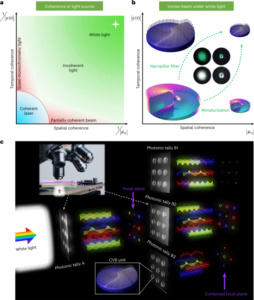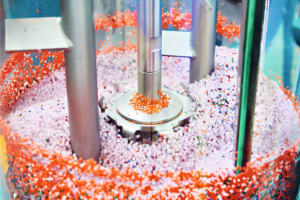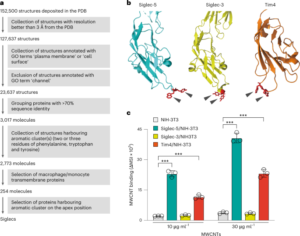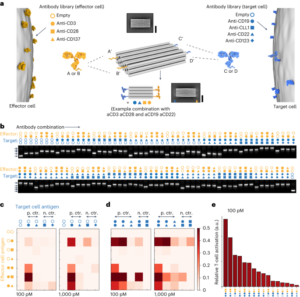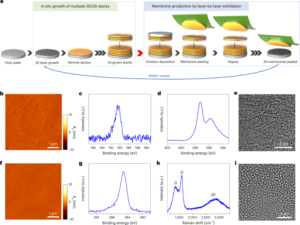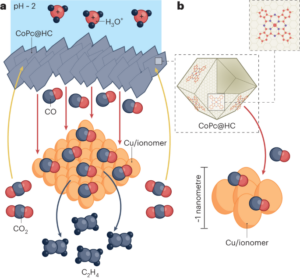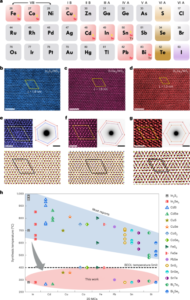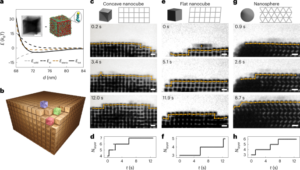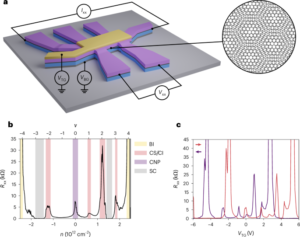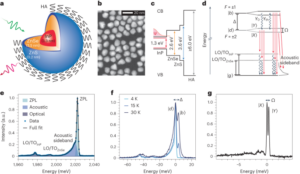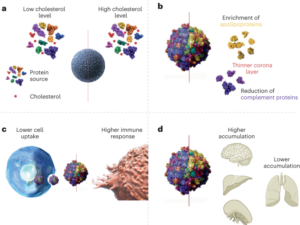
Nanopore array fabrication
Nanopore arrays are fabricated as reported before27. In brief, a 100-nm-thick layer of poly(methyl methacrylate) electron-sensitive resist (molecular weight 950,000, 3% dissolved in anisole, MicroChem Corp) was spin-coated on 20 nm free-standing silicon nitride membranes supported by silicon. Subsequently, the resist was exposed and patterned by an electron-beam pattern generator (EBPG5200, Raith) with 100 keV electron beams. The pattern is developed in a mixture of methyl-isobutyl-ketone and isopropanol with a ratio of 1:3 for 1 min, then stopped in isopropanol for 30 s. The exposed substrates were then etched using reactive-ion etching with fluoroform and argon (200 s, 50 W, 50 sccm of CHF3, 25 sccm of Ar, 10 μbar, SENTECH SI 200 plasma system). Finally, the resist was removed in oxygen plasma for 1 min (200 cm3 min−1 O2, 100 W, PVA TePla 300) followed by an acetone bath for 5 min.
Design, folding and purification of DNA origami structures
All structures were designed using caDNAno v.0.228. For the cryo-EM reconstruction of the turbine part, all structures were designed with a compact beam on top of each turbine structure (Supplementary Figs. 6 and 7) and designed only using a 7,560-base-long scaffold. The folding reaction mixtures contained a final scaffold concentration of 50 nM and oligonucleotide strands (IDT) of 500 nM. The folding reaction buffer contained 5 mM Tris, 1 mM EDTA, 5 mM NaCl and 20 mM MgCl2. The folding solutions were thermally annealed using TETRAD (MJ Research, now Bio-Rad) thermal cycling devices. The reactions were left at 65 °C for 15 min and then subsequently subjected to a thermal annealing ramp from 60 °C to 20 °C (1 °C h−1). The folded structures were purified from excess oligonucleotides by physical extraction from agarose gels and stored at room temperature until further usage. The list of oligonucleotides can be found in Supplementary Information.
The turbine structure with a long DNA bundle as load was designed using a scaffold of 8,064 bases and a scaffold of 9,072 bases. The folding reaction mixtures contained a final scaffold concentration of 10 nM plus oligonucleotide strands (IDT) of 100 nM each. The folding reaction buffer contained 5 mM Tris, 1 mM EDTA, 5 mM NaCl and 15 mM MgCl2 for the left-handed and right-handed versions or 20 mM MgCl2 for the achiral version of the turbine. The folding reaction mixtures were thermally annealed using TETRAD (MJ Research) thermal cycling devices. The reactions were left at 65 °C for 15 min and then subjected to a thermal annealing ramp from 60 °C to 20 °C (1 °C h−1). The folded structures were purified from excess oligonucleotides by polyethylene glycol precipitation and stored at room temperature until further usage. Details of all the procedures can be found in ref. 29.
Cryo-EM sample preparation, image acquisition and processing
Grid preparation, image acquisition and data processing were largely performed as reported previously30. The sample was applied to a glow-discharged C-Flat 1.2/1.3 4C thick grid (Protochips) and vitrified using a Vitrobot mark IV (FEI, now Thermo Scientific) at a temperature of 22 °C, a humidity of 100%, 0 s wait time, 2 s blot time, −1 blot force (arbitrary device units) and 0 s drain time. Micrograph videos with 10 frames were collected for the right-handed and left-handed versions (3,427 and 5,997 respectively) at a magnified pixel size of 2.28 Å and an accumulated dose of ~60 e Å−2 using the EPU software and a Falcon 3 detector (FEI) on a Cs-corrected (CEOS) 300 kV Titan Krios electron microscope (FEI). For the left-handed version, acquisition with a stage tilt of 20° was used to reduce the orientation bias of the particles.
Motion correction and contrast transfer function estimation of the micrographs were performed using the implementation in RELION 4.0 beta31,32 and CTFFIND4, respectively33. Particles were autopicked using TOPAZ34 and subjected to a selection process consisting of multiple rounds of 2D and 3D classification in RELION to remove falsely picked particles and damaged particles. Using an ab initio initial model, a refined 3D map was reconstructed from 97,054 and 71,992 particles for the right-handed and left-handed versions, respectively, followed by per-particle motion correction and dose weighting and 3D refinement (Supplementary Figs. 6 and 7). For a focused reconstruction of the turbine, multibody refinement35 was performed. The consensus map was divided into two parts containing the lever and the turbine using the eraser tool in UCSF Chimera36, and low-pass-filtered soft masks of the respective regions were created in RELION (Supplementary Figs. 8 and 9). After multibody refinement, a set of particles with the subtracted signal of the lever arm was calculated and subjected to another round of 3D refinement. The final maps were masked, sharpened and low-pass filtered using the estimated resolution based on the 0.143 Fourier shell correlation criterion. Atomic models were constructed using a cascaded relaxation protocol as described previously30 (Supplementary Fig. 11).
The dimensions of the turbines were measured in Fiji37 using orthographic projections of the maps created with ChimeraX38. For the twist measurement of the turbine versions, slices from the well resolved central parts were extracted from the cryo-EM density maps using atomic model fits at base-pair positions that are on the same plane in the design, with a spacing of 33 bp and 34 bp for the right- and the left-handed version, respectively (Supplementary Fig. 10). For each version, the slices were fitted into each other on the basis of maximum overlay using ChimeraX38 to determine the rotation angle. From the twist density, the diameter and the length of the helices, the outer blade angle with respect to the helical axes was calculated.
Single-particle fluorescence imaging
Solid-state nanopore chips were oxygen-plasma cleaned before all the fluorescence experiments (100 W for 1 min, Plasma Prep III, SPI Supplies). Coverslips (VWR, no. 1.5) were cleaned by ultrasonication sequentially in acetone, isopropanol, water, 1 M KOH solution and deionized water (Milli-Q) for 30 min each. The cleaned coverslips were then blow-dried thoroughly with compressed nitrogen. The nanopore chip was glued into the PDMS (SYLGARD 184 silicone elastomer) flow cell using a two-component silicone rubber (Ecoflex 5, Smooth-ON), then the PDMS flow cell was bonded to the cleaned coverslip after oxygen-plasma treatment (50 W, 50 mbar for 30 s) and post-bake at 120 °C for 30 min. After assembly, the whole device was again treated with oxygen plasma (50 W, 50 mbar) for 4 min before embedding a pair of Ag/AgCl electrodes, one in each side of the reservoir, and flushing in deionized water to wet the channels. This is essential for increasing the hydrophilicity of the membrane and ensuring a negatively charged silicon nitride surface. The PDMS nanopore devices were always assembled shortly before each experiment and never reused.
The nanopore chip was then imaged using an epifluorescence microscope with a ×60 water immersion objective (Olympus UPlanSApo, numerical aperture 1.20) and a fast scientific complementary metal–oxide–semiconductor camera (Prime BSI, Teledmy Photometrics). The camera field of view was reduced as needed to achieve high frame rates (typically around 200 pixels × 200 pixels). To image Cy3-labelled DNA turbines, a 561 nm laser (Stradus, Vortran Laser Technology) was used to excite the fluorophores. The typical exposure time of the experiments was 5 ms, which led to a frame rate of around 190–200 fps. To simplify the data analysis, a fixed frame rate value (200 fps) is used. Before imaging, the imaging buffer (50 mM Tris-HCl pH 7.5; 50 mM NaCl unless otherwise stated, 5 mM MgCl2; 1 mM dithiothreitol, 5% (w/v) d-dextrose, 2 mM Trolox, 40 μg ml−1 glucose oxidase, 17 μg ml−1 catalase; 0.05% TWEEN 20) was placed into the reservoirs on either side of the silicon nitride membrane.
Driving DNA turbines using transmembrane ion gradients
An imaging buffer with the same salt concentration (50 mM NaCl) was flushed into the flow cell first, with DNA turbines on the cis side of the membrane. Subsequently, an imaging buffer containing a higher NaCl concentration was flushed into the trans side of the membrane. With single-particle fluorescence microscopy, the docking and rotation of the DNA turbines could be observed and recorded. To release the turbines from the nanopore, we either inserted a pair of temporary electrodes into the inlet and outlet of the flow channels and released the turbines electrically, or we flushed in the same (lower-concentration) buffer as the cis side. Because of the photobleaching and accumulation of the DNA turbines near nanopore arrays, we chose 40 s as a typical observation duration. Examples of longer recordings are shown in Supplementary Fig. 23.
Driving DNA turbines using transmembrane voltages
In contrast to the salt-gradient-driven mode, a pair of electrodes was embedded into the flow cells. We used a custom-built circuit to apply voltages39. The output voltage was controlled by a custom LabVIEW program. The electrodes embedded in the two reservoirs were connected to the circuit. The DNA origami turbines were placed into the electrically grounded side (cis side) of the flow cell with a typical concentration of 1 pM. After applying the voltage, the DNA turbines were docked onto the nanopores under a 100 mV bias voltage (unless otherwise stated) across the membrane. The turbines could be easily released from the nanopore array by flipping the voltage polarity and then setting it to 0 mV for several seconds to allow the imaged turbines to diffuse away from the capture region. To avoid overcrowding of DNA turbines near the nanopore array, which increased the fluorescence background fluctuation, we typically imaged the turbines before the array was fully filled, and subsequently released them from the nanopore. Then a new group of turbines could be captured and docked again by applying a positive bias.
Fluorescence microscopy data analysis
For image processing, first a single-molecule localization was carried out using Fiji (ImageJ37) with the ThunderSTORM plugin40 for all frames in the acquired image sequences. A wavelet filter (B-spline) and an integrated Gaussian method were used for the localizations. Then the results were filtered on the basis of their quality (uncertainty < 50 nm) and the local density (filter of 15 particles in every 50 nm among all localized data points in the sequence) to rule out free-diffusing (non-captured) turbines. Next, the single-molecule localization results were analysed using a custom MATLAB script (Code availability). In brief, all coordinates of localized particle positions were clustered on the basis of their Euclidean distance for each turbine. When localized particle positions were deduced in a video, a circle was fitted to the data to obtain the centre and a radius, which subsequently was used for calculating the angular position of the fluorophores in each frame. Next, we determined if the fluorophores occupy spatial states that can be fitted to a circular path. We did this by comparing the point density of the coordinates within an annulus around the fitted circular perimeter (±1 nm) with the density of points around the centre (with a radius r, so that the area of this central circle is equal to that of the ring region). If the point density within the annulus was higher, then this data group would be kept in the statistics, else it would be considered an invalid trajectory and discarded. Finally, the script calculated all necessary motion properties of the turbine, including its cumulative angular displacements, MSD, angular velocity and torque. The angular velocity ωd was determined by fitting MSD = ωd2t2 + 2Drt to the MSD curve of each turbine, where t is the lag time and Dr is the rotational diffusion coefficient (also as a fitting parameter). The estimation of the torque is discussed in Supplementary Section 1.
MD simulations
All MD simulations were performed using the NAMD program41, CHARMM36 parameters for DNA, water and ions42 with CUFIX43 corrections, periodic boundary conditions and the TIP3P model of water44. The long-range electrostatic interactions were computed using the particle-mesh Ewald scheme over a grid with 1 Å spacing45. Van der Waals and short-range electrostatic forces were evaluated using the 10–12 Å smooth cutoff scheme. Hydrogen mass repartitioning46 and the SHAKE47 and SETTLE48 algorithms were used, enabling a 4 fs integration time step. The full electrostatics were calculated every two-time step. Except where specified, a Langevin thermostat with a 0.1 ps−1 damping coefficient maintained a temperature of 295 K in all simulations. Coordinates were recorded every 2,500 steps.
Atomistic models of the entire turbine were assembled from the caDNAno28 design file using a custom mrdna script49. In addition to neutralizing Mg2+, 10 mM Mg2+ hexahydrate was placed adjacent to the DNA according to a previously described protocol43. Water and monovalent ions were added to the system using the solvate and autoionize plugins for VMD50, with the solvent box cut to form a hexagonal prism. For each salt condition, a 4 ns simulation was performed with a Nosé–Hoover Langevin piston barostat51,52 set to maintain a target pressure of 1 bar, allowing the equilibrium volume of the system to be determined. The resulting system dimensions were used in constant-volume simulations to equilibrate the turbine with harmonic position restraints holding the phosphorus atoms to their initial coordinates during the first 7 ns of the simulation (kspring = 1 kcal mol–1 Å–2 for t < 5 ns; 0.1 for 5 ns < t < 7 ns). After 30 ns of equilibration for the 50 mM and 75 ns for the 3 M system, a snapshot of the configuration was used to initialize subsequent simulations with either an electric field or pressure gradient applied to drive the turbine. Additional equilibration was performed for the 50 mM NaCl system for another 128 ns to initialize the ‘Alternate conf.’ system (Supplementary Fig. 24).
The conformation of the turbine at the end of equilibration was used to determine the rest positions of several harmonic collective variable (colvar)53 potentials, including a spring restraining the centre of mass of every third phosphorus atom (kspring = 500 kcal mol–1 Å–2); a spring restraining the root-mean-square deviation (RMSD) of these phosphorus atoms with respect to the post-equilibration configuration (kspring = 1,000 kcal mol–1 Å–2; resting RMSD = 0), after optimal rigid body transformations so that the potential does not apply a net torque or force; and a pair of centre of mass harmonic restraints applied to 16-bp-long sections of the central six-helix bundle (kspring = 50 kcal mol–1 Å–2), placed near either the end of the shaft to prevent the turbine from tilting. With these colvars preventing translation, conformational fluctuations, or tilting of the turbine, an electric field was applied by placing a constant force on each atom with a magnitude proportional to the charge of the atom. Similarly, a pressure gradient was achieved by placing a small force on every water molecule of the system. Finally, in simulations where the torque was measured, an additional spin angle colvar (kspring = 100 kcal mol–1 °–2) prevented rotation of the turbine and reported the torque.
Simulation systems were prepared to study the forces on and flows around a DNA helix mimicking the DNA in the turbine blade. The 21 bp helix was made effectively infinite by connecting the ends of each strand across the periodic boundary. Solvent (neutralizing Na+, 100 mM and 3 M NaCl; no Mg2+) was added around the helix. Systems were equilibrated for 5–50 ns with the DNA phosphorus atoms harmonically restrained (kspring = 0.2 kcal mol–1 Å–2). Mobility measurements were performed using a field of 5 mV nm−1 or a hydrostatic pressure of ~1.3 bar nm−1 parallel or transverse to the helical axis, with each condition employing four replicate simulations lasting a total of 400 (neutralizing Na+) to 4,000 ns (3 M). Except where otherwise specified, a 100 mV nm−1 electric field was applied to the system at a 35° angle with respect to the DNA while a centre of mass colvar restrained the DNA (kspring = 500 kcal mol–1 Å–2), an RMSD colvar retained an idealized DNA configuration (kspring = 100 kcal mol–1 Å–2) and a spin angle colvar (kspring = 100 kcal mol–1 °–2) prevented rotation of the DNA and reported on the torque. Eight replicate systems were employed during simulations lasting a total of 1,040 ns (100 mM) or 2,055 ns (3 M). The flow and concentration of ions and water oxygen atoms were analysed by binning the system into ~1 Å voxels, counting the flux through and concentration in each voxel using a centred finite-difference approximation for the flux. The difference in concentration between sodium and chloride ions provided the net local charge density of the fluid around the DNA in each case. Multiplying this charge by the electric field provided the solvent force. In subsequent simulations, the 3D map of the solvent force was used to apply a position-dependent force to each water oxygen atom using the TclBC feature of NAMD and employing the approximation that the density of water oxygen atoms is uniformly 33 nm−3. Again, eight replicate systems were employed for simulations lasting a total of 480 and 570 ns for 100 mM and 3 M conditions, respectively.
Statistics and reproducibility
No statistical method was used to predetermine the sample size.
- SEO Powered Content & PR Distribution. Get Amplified Today.
- PlatoData.Network Vertical Generative Ai. Empower Yourself. Access Here.
- PlatoAiStream. Web3 Intelligence. Knowledge Amplified. Access Here.
- PlatoESG. Carbon, CleanTech, Energy, Environment, Solar, Waste Management. Access Here.
- PlatoHealth. Biotech and Clinical Trials Intelligence. Access Here.
- Source: https://www.nature.com/articles/s41565-023-01527-8
- :is
- :not
- :where
- ][p
- 000
- 1
- 10
- 100
- 11
- 13
- 14
- 15%
- 16
- 17
- 1994
- 1995
- 1996
- 20
- 200
- 2012
- 2013
- 2014
- 2015
- 2017
- 2018
- 2019
- 2020
- 2021
- 22
- 23
- 25
- 27
- 28
- 29
- 2D
- 30
- 300
- 31
- 32
- 33
- 35%
- 36
- 39
- 3d
- 40
- 400
- 41
- 46
- 49
- 50
- 500
- 51
- 52
- 53
- 60
- 65
- 7
- 75
- 8
- 9
- 97
- 98
- a
- accelerating
- According
- Accumulated
- accumulation
- accurate
- Achieve
- achieved
- acquired
- acquisition
- across
- added
- addition
- Additional
- additive
- adjacent
- After
- again
- AL
- algorithm
- algorithms
- All
- allow
- Allowing
- also
- always
- among
- an
- analysis
- Analytical
- Anchor
- and
- Angular
- Another
- applied
- Apply
- Applying
- AR
- ARE
- AREA
- ARM
- around
- Array
- AS
- assembled
- Assembly
- At
- atom
- Automated
- availability
- avoid
- away
- AXES
- Axis
- b
- background
- bar
- based
- basis
- Bayesian
- BE
- Beam
- because
- before
- between
- bias
- BLADE
- body
- Box
- BP
- Breakdown
- buffer
- Bundle
- by
- calculated
- calculating
- camera
- CAN
- capture
- captured
- carried
- case
- cell
- Cells
- central
- centre
- CEOs
- channels
- charge
- charged
- chip
- Chips
- chose
- Circle
- classification
- click
- code
- Collective
- compact
- comparing
- comparison
- complementary
- comprehensive
- concentration
- condition
- conditions
- Configuration
- connected
- Connecting
- Consensus
- considered
- Consisting
- constant
- constraints
- contained
- contrast
- controlled
- Corp
- Corrections
- Correlation
- could
- counting
- CPU
- created
- curve
- custom
- Custom-built
- Cut
- data
- data analysis
- data points
- data processing
- density
- described
- Design
- designed
- details
- determination
- Determine
- determined
- developed
- developers
- deviation
- device
- Devices
- DID
- difference
- Diffusion
- dimensions
- discussed
- distance
- divided
- dna
- does
- dose
- douglas
- drain
- drive
- duration
- during
- dynamics
- e
- E&T
- each
- easily
- educators
- effectively
- either
- Electric
- else
- embedded
- embedding
- employed
- employing
- enabling
- end
- ends
- ensuring
- Entire
- equal
- equations
- Equilibrium
- essential
- estimated
- Ether (ETH)
- evaluated
- Every
- examples
- Except
- excess
- experiment
- experiments
- exposed
- Exposure
- extraction
- falcon
- FAST
- Feature
- fei
- field
- Fig
- File
- filled
- filter
- final
- Finally
- First
- fitting
- fixed
- flow
- Flows
- fluctuation
- fluctuations
- fluid
- Flushed
- FLUX
- focused
- followed
- For
- Force
- Forces
- form
- found
- four
- fps
- FRAME
- from
- FS
- full
- fully
- function
- functions
- further
- generator
- GPU
- graph
- Graphene
- Grid
- Group
- High
- higher
- holding
- How
- HTTPS
- hydrogen
- if
- iii
- image
- Imaging
- immersion
- implementation
- improved
- in
- Including
- increased
- increasing
- initial
- integrated
- integration
- interactions
- into
- IT
- ITS
- kept
- large
- largely
- laser
- lasting
- layer
- Led
- left
- Length
- LINK
- Liquid
- List
- load
- local
- Localization
- Long
- longer
- made
- maintain
- make
- map
- Maps
- mark
- Masks
- Mass
- material
- maximum
- measured
- measurement
- measurements
- mesh
- method
- methods
- Microscope
- Microscopy
- min
- mixture
- MJ
- mobility
- Mode
- model
- models
- MOL
- molecular
- molecule
- motion
- motions
- MS
- multiple
- multiplying
- nano
- nanopore
- nanotechnology
- Nature
- Near
- necessary
- needed
- negatively
- net
- networks
- Neural
- neural networks
- never
- New
- next
- no
- now
- objective
- observation
- observed
- obtain
- of
- olympus
- on
- ONE
- only
- open source
- optimal
- optimization
- or
- Other
- otherwise
- out
- outlet
- output
- over
- Oxygen
- pair
- palm
- Parallel
- parameter
- parameters
- part
- particle
- parts
- path
- Pattern
- performed
- periodic
- physical
- picked
- Pixel
- placed
- placing
- plane
- Plasma
- platform
- plato
- Plato Data Intelligence
- PlatoData
- plugins
- plus
- pm
- Point
- points
- position
- positions
- positive
- potential
- potentials
- powered
- predicting
- preparation
- prepared
- pressure
- prevent
- preventing
- previously
- Prime
- procedures
- process
- processing
- Program
- projections
- properties
- Protein
- protocol
- prototyping
- provided
- quality
- R
- Ramp
- rapid
- Rate
- Rates
- ratio
- reaction
- reactions
- recorded
- reduce
- Reduced
- reference
- refined
- region
- regions
- relaxation
- release
- released
- remove
- Removed
- Reported
- research
- researchers
- Resolution
- resolved
- respect
- respective
- respectively
- REST
- resting
- resulting
- Results
- retained
- revealing
- rigid
- Ring
- Room
- round
- rounds
- rubber
- Rule
- s
- salt
- same
- scalable
- scheme
- SCI
- scientific
- script
- seconds
- Section
- sections
- selection
- Sequence
- set
- setting
- settle
- several
- shapes
- Shell
- Shortly
- shown
- side
- Signal
- Silicon
- silicone
- Similarly
- Simple
- simplify
- simulation
- Size
- small
- smooth
- Snapshot
- So
- sodium
- Soft
- Software
- solution
- Solutions
- Spatial
- specified
- Spin
- spring
- Stage
- stated
- States
- statistical
- statistics
- Step
- Steps
- stopped
- stored
- Storm
- Strands
- structure
- structures
- Study
- subsequent
- Subsequently
- sums
- supplies
- Supported
- Surface
- system
- Systems
- T
- Target
- Technology
- temporary
- that
- The
- The Area
- their
- Them
- then
- theory
- thermal
- thermostat
- These
- Third
- this
- thoroughly
- Through
- time
- titan
- to
- tool
- tools
- top
- Total
- trajectory
- transfer
- transformations
- Translation
- treated
- treatment
- turbine
- twist
- two
- typical
- typically
- Uncertainty
- under
- units
- until
- Usage
- used
- using
- value
- variable
- VeloCity
- version
- Video
- Videos
- View
- visualization
- Voltage
- volume
- Voxel
- Voxels
- W
- wait
- was
- Water
- we
- weight
- WELL
- were
- when
- which
- while
- whole
- with
- within
- would
- york
- zephyrnet
- zhang

